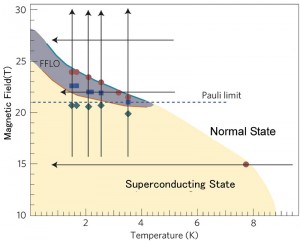Observation of an anomalous superconducting state under high magnetic fields Experimental evidence for the FFLO superconducting state

A France-Japan-US collaborative research group (H. Mayaffre, S. Kramer, M. Horvatic’, C. Berthier at Laboratoire National de Champs Magne’tiques Intenses, France; K. Miyagawa, K. Kanoda at Department of Applied Physics, University of Tokyo, Japan; V. F. Mitrovic’at Brown University, USA) succeeded in observing the sought-after peculiar superconducting state (called FFLO state), that survives under strong magnetic fields.

© 2014 Kazushi Kanoda.
Field-Temperature phase diagram of a layered organic superconductor. The vertical and horizontal axes show respectively the strength of the external field (Tesla) and temperature (Kelvin). The FFLO state is observed in the grayish area in the phase diagram. The NMR experiments were performed along the bold lines. The "Normal state" stands for a non-superconducting metallic state.
Because an electric current can flow without dissipative heating in a superconducting material, superconductivity has been studied intensively in both fundamental and applied research. While superconducting materials are used under a magnetic field, a strong magnetic field generally destroys the superconducting state. So, the behavior of superconductors under magnetic fields is of keen interest.
In a superconducting state, electrons, which carry charges and minute magnets called spins form pairs in which the spins are anti-parallel (called Cooper pairs). An external magnetic field induces the motion of the Cooper pairs and forces the anti-parallel spins, which cancelled each other out, to align parallel to the field direction. Both effects act to break the Cooper pairs so that the strong magnetic field destroys the superconducting state. However, even in such destructively high fields, a peculiar superconducting state called FFLO (Fulde-Ferrell-Larkin-Ovchinnikov) state, was predicted to be able to survive by spatially undulating the density of Cooper pairs. This state has long been sought after experimentally but its existence remained unclear.
The research group has investigated an organic superconductor under high magnetic fields by means of the NMR technique and captured evidence for the FFLO state. This finding hints at the possibility of overcoming the magnetic field limitations of the conventional mechanism of superconductivity.
Paper
H. Mayaffre, S. Kramer, M. Horvatic, C. Berthier, K. Miyagawa, K. Kanoda, V. F. Mitrovic,
“Evidence of Andreev bound states as a hallmark of the FFLO phase in κ-(BEDT-TTF)2Cu(NCS)2 ”,
Nature Physics Online Edition: 2014/10/26, doi: 10.1038/nphys3121.
Article link
Links
Graduate School of Engineering
Department of Applied Physics, Graduate School of Engineering
Kanoda Group, Department of Applied Physics, Graduate School of Engineering (Japanese)






